Turtles are truly fascinating creatures that have graced our planet for millions of years. As we delve into the world of the most colorful turtles, we will discover the distinctive characteristics and fascinating beauty of species like the Painted Turtles, Red-Eared Sliders, Eastern Box Turtles, and Diamondback Terrapins. From their vibrant shells and skin patterns to their unique behaviors and ecological roles, these turtles captivate the hearts and minds of people across the globe.
Colorful Turtle Species
Painted Turtles are some of the most colorful turtles that can be found in North America. They have a dark shell with red and yellow markings on the bottom, and their head, neck, and legs also have yellow and red stripes. These colorful turtles are usually found in slow-moving freshwater habitats, such as ponds, marshes, and lakes. They enjoy basking in the sun on logs or rocks, and they are good swimmers. Painted Turtles can be found in most of the United States, as well as parts of Canada and Mexico.
Another colorful turtle species is the Red-Eared Slider. These turtles get their name from the red markings on each side of their head, which look like little red ears. They also have a green shell with yellow and black markings, and their skin is covered in intricate yellow patterns. Red-Eared Sliders are native to the southeastern United States, but they have been introduced to other parts of the world as pets and can now be found in various habitats, including ponds, streams, and lakes in Europe, Asia, and Australia.
Eastern Box Turtles are small, colorful turtles known for their high-domed shells and bright yellow, orange, or red patterns on a brown or black background. These terrestrial turtles can be found in forests, fields, and wetlands throughout the eastern United States. A unique feature of the Eastern Box Turtle is its hinged plastron, which allows it to close its shell tightly when it feels threatened. These turtles are omnivores, feeding on a variety of insects, plants, and even carrion.
Diamondback Terrapins are beautifully patterned turtles with grey, brown, or black skin and unique diamond-shaped patterns on their shells. Their skin also features white, yellow, or green spots and flecks. These turtles are unique because they live in brackish water habitats, such as estuaries and salt marshes, which are a mix of salt and freshwater. Native to the eastern and southern United States, Diamondback Terrapins are well-adapted to their environment, with webbed feet for swimming and strong jaws for crushing the shells of their favorite prey, such as snails, crabs, and mollusks.
Among the many fascinating turtle species, some of the most colorful ones have a unique anatomy and physiology that allows them to demonstrate stunning shell patterns, vibrant skin colors, and various functions in nature. These vibrant colors on a turtle’s shell, known as scutes, are formed by layers of keratin, which is the same protein found in our hair and nails. The bright colors and patterns are not only pleasing to the eye but serve specific purposes in a turtle’s life, such as communication, camouflage, and protection from predators.
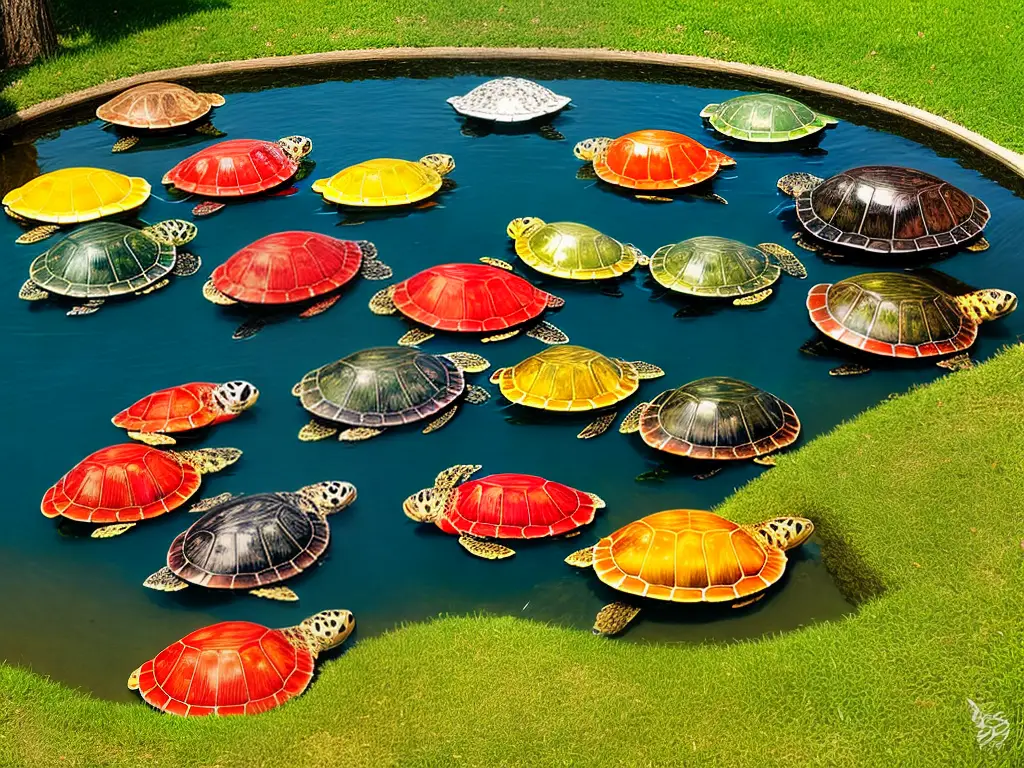
The Vibrant Colors and Patterns of Turtle Species
One more fascinating turtle species known for its vibrant colors is the Yellow-Bellied Slider. Similar in appearance to the Red-Eared Slider, these turtles have a bright yellow plastron and yellow stripes on their head, neck, and legs. They also have a dark green or black shell with irregular yellow markings. Yellow-Bellied Sliders can be found in the southeastern United States and prefer slow-moving freshwater habitats, including swamps, ponds, and marshes. As they bask in the sun or glide through the water, their vivid coloration adds a splash of beauty to their environment, drawing attention to the impressive ways in which color plays a role in their survival and adaptation to the natural world.
One example of a visually striking turtle species is the painted turtle, which has a smooth and flat shell adorned with intricate patterns and a kaleidoscope of colors, including red, yellow, and orange. Their skin is also decorated with colorful markings that extend from their head down to their legs. These patterns serve as a form of camouflage, enabling them to blend in with their surroundings in the water, which makes it difficult for predators to spot them.
In addition to camouflage, the bright colors on some turtle species also serve as a means of communication. For instance, the male red-eared slider turtle is known for its bright red patch of skin around its ears. This coloration not only makes the turtle visually attractive but also plays an essential role in communication during mating rituals. Males use their vibrant, colorful markings to attract and court females or to warn off other males.
The vibrant colors of the Eastern box turtle serve a slightly different purpose in nature. The shell of the Eastern box turtle, which features a mix of yellow, orange, and brown, closely resembles the appearance of fallen leaves when viewed from above. This can help camouflage the turtle from aerial predators, such as birds of prey. When threatened, the Eastern box turtle is also able to protect itself by retracting its limbs, tail, and head into its shell, creating a tight seal.
Turtles are fascinating creatures that come in various vibrant colors, with some species having the ability to change the color of their skin or shell over time. This process, known as color morphism, can be an adaptation to their environment or a result of aging. For example, the Green Sea Turtle can exhibit different shades of green, grey, or brown on its shell, depending on its location and diet. When they hatch from their eggs, Green Sea Turtles have dark-colored shells for camouflage in the sand. However, as they grow older and spend more time in the ocean, their shells may lighten or darken due to exposure to sunlight or as a result of the types of algae they consume. Thus, the colorful shells, skin patterns, and vibrant colors displayed by different types of turtles not only make them visually appealing but also offer them survival benefits ranging from protection to communication in the natural world.
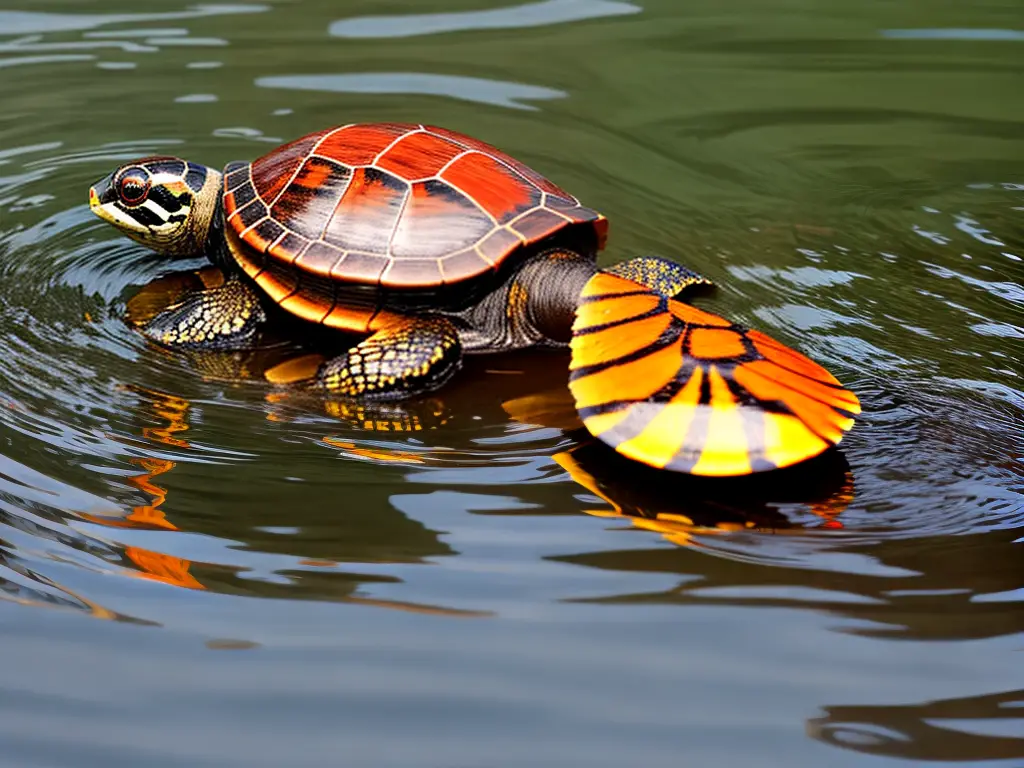
The Colorful Diet of Turtles
These mesmerizingly colorful turtles can be found in various habitats around the world, and their diet can differ depending on their surroundings. Some turtles, like the Painted Turtle and the Red-eared Slider, are omnivores, meaning they consume both plants and animals. They primarily feed on aquatic vegetation, insects, and small fish in their freshwater environments. Conversely, some marine species like the Hawksbill Sea Turtle mainly feed on animals such as sponges, jellyfish, and other invertebrates. Regardless of their colorful appearance, these turtles play a crucial role in maintaining the health and balance of their respective ecosystems.
The diet of a colorful turtle can also change as they grow older. Young turtles, also known as hatchlings, usually have a higher protein requirement for their rapid growth and development. This is why most hatchlings prefer eating more insects, worms, and small fish. As they grow older, their diet becomes more balanced, with adult turtles consuming more plants than younger ones.
The food sources available in a turtle’s environment can greatly influence their coloration. For instance, the striking colors of a Painted Turtle or a Red-eared Slider are thought to be linked to the pigments present in the plants and algae they consume. These pigments, known as carotenoids, are responsible for giving plants their bright colors and also contribute to the coloration of the turtles that eat them.
A turtle’s ability to maintain its striking colors can also be affected by the quality of the food it eats. In the wild, turtles have access to a wide variety of food sources that help provide the necessary nutrients to maintain their vibrant colors. However, in captivity, where turtles rely on the food provided by their caretakers, their diet may lack essential nutrients, which can cause their colors to fade over time. Therefore, it is crucial to ensure that a pet turtle’s diet closely mimics the variety of foods it would naturally consume in the wild.
Colorful turtles are fascinating creatures that capture our attention with their vivid hues and captivating patterns. A key factor in maintaining their bright colors is their diet and nutrition, which is important to understand for their overall health and survival. By providing turtles in captivity with an adequate and varied diet, we can help them maintain their stunning appearance that contributes to our fascination with them. Furthermore, studying their food sources could enhance our understanding of their biology and aid in conservation efforts.
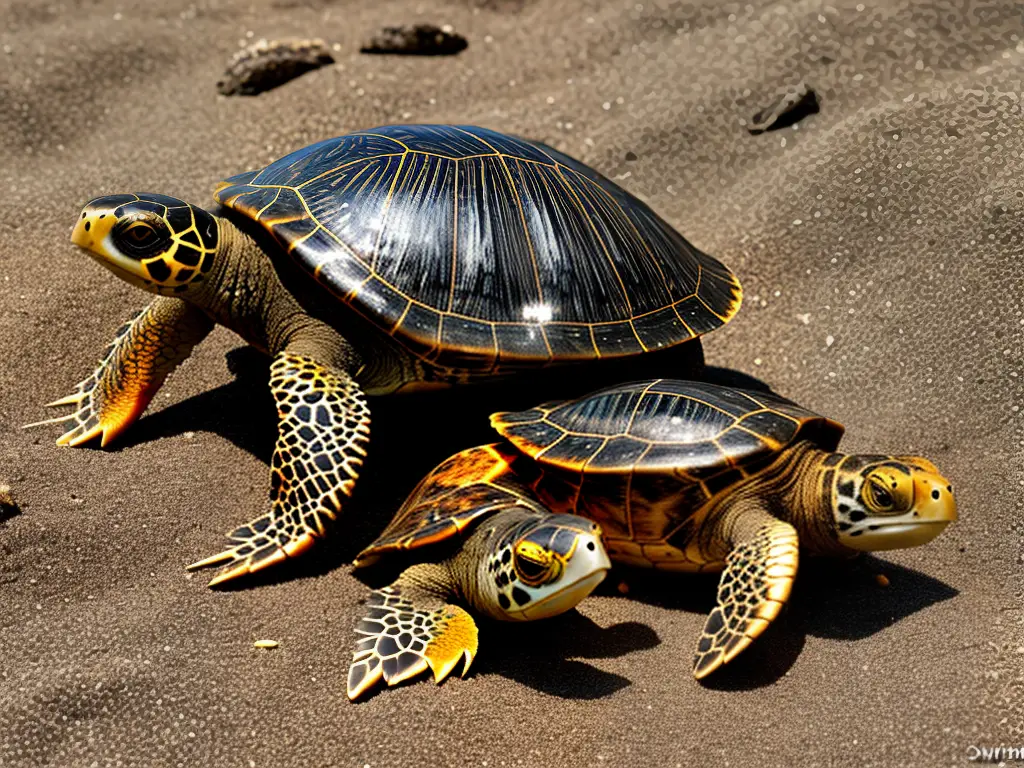
The Fascinating Behavior of Colorful Turtles
Aside from their vibrant appearance, colorful turtles have unique and intriguing mating, nesting, and social interactions. Their shell and skin colors serve both as a visual display and a vital role in their communication and understanding of their surroundings. One of the most strikingly colored species is the Painted Turtle, known for its red, yellow, and orange markings on its shell and body. Other colorful turtles, such as the Red-Eared Slider and the Eastern Box Turtle, also captivate us with their vibrant hues and interesting behavioral patterns.
During the mating season, which usually occurs in spring and autumn, male colorful turtles display striking behavior to attract females. They court the females by extending their necks, displaying their vibrant skin colors, and swimming around the females while fluttering their front claws near the female’s face. This elaborate courtship behavior helps males not only to grab the attention of female turtles but also to communicate their fitness and potential as a partner. Female turtles are believed to select a mate based on the males’ visual appearance to ensure strong and healthy offspring.
Nesting is another essential aspect of colorful turtles’ behavior. Female turtles typically search for suitable nesting sites on land close to their aquatic habitats. They prefer areas with sandy or loamy soil that offers the right balance of moisture and warmth necessary for successful incubation of their eggs. Female turtles are known to be very particular about the location of their nests, using their keen perception of color and light to navigate to the perfect nesting spot. Once a suitable location is found, female turtles dig a hole using their rear legs and lay their eggs in the nest, which they cover with soil for protection.
Colorful turtles, being ectothermic like all reptiles, rely on the heat from the environment for regulating their body temperature. These turtles bask in the sunlight to absorb heat and synthesize Vitamin D. They also use their vibrant colors to help regulate their body temperature. The dark patches on their shells help them absorb sunlight and warm up, while lighter markings may serve to reflect excess heat and prevent the turtle from overheating.
Social interactions among colorful turtles vary depending on the species. Some turtles, like painted turtles and red-eared sliders, are known to form groups called bale when basking in the sun or foraging for food. Studies have shown that these turtles recognize each other based on their colors and markings, and they tend to prefer the company of those with similar appearances. On the other hand, Eastern box turtles are more solitary and are rarely seen interacting with other turtles except during mating. These turtles rely on their color patterns for camouflage in their terrestrial habitats to avoid predators, using their well-adapted shells for protection when needed.
Colorful turtles such as the painted turtle, red-eared slider, and hawksbill sea turtle showcase fascinating behavior and communication, with color playing a significant role in their mating, nesting, and social interactions. Their vibrant appearance not only serves as a visual cue for other turtles, but it also helps them effectively navigate their environments and maintain their overall health. Studying these intriguing behaviors further helps us to better understand these vibrant creatures and the intricate ways they communicate and interact with their surroundings.
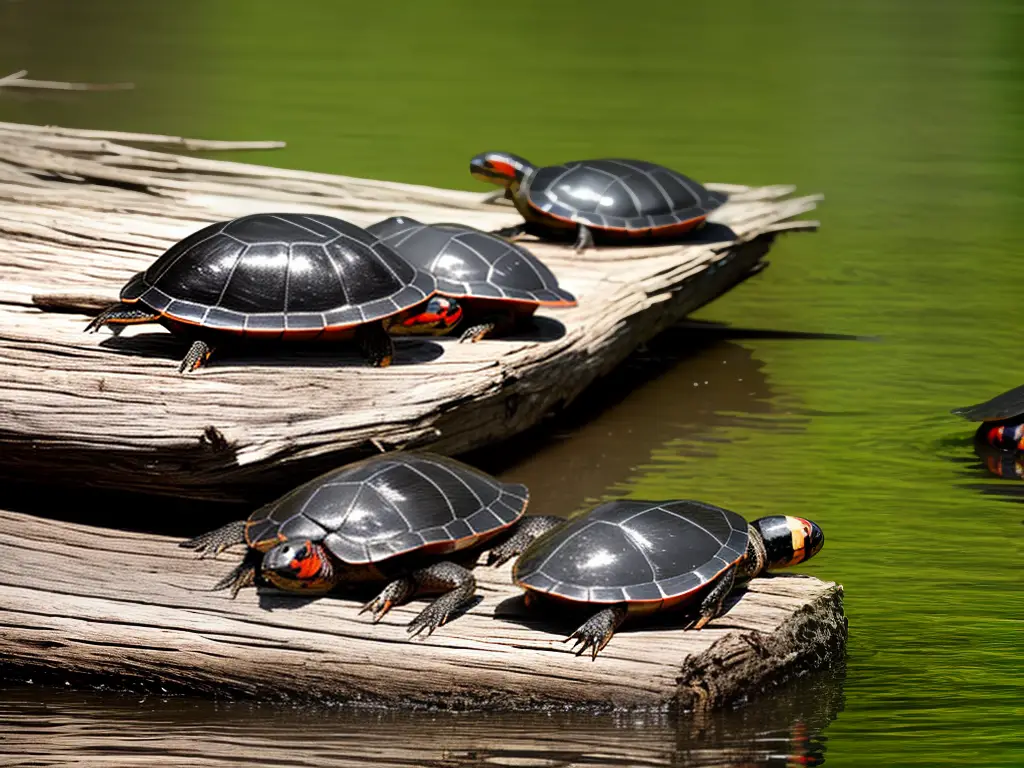
Challenges and Conservation of Colorful Turtles
Unfortunately, these colorful turtles face numerous challenges in their natural habitats due to human activities. Habitat loss is a predominant threat for these vibrant creatures, as their ecosystems are often destroyed or altered by human development, agricultural expansion, and deforestation. As their habitats shrink, turtles struggle to find food, shelter, and appropriate nesting sites, leading to a decline in their populations. It is crucial that we continue to learn about and protect these beautiful and unique animals, in order to help ensure their survival and the preservation of their crucial roles in their ecosystems.
Pollution is another significant challenge for colorful turtles. Plastic waste, chemical contaminants, and oil spills in aquatic environments can have a devastating impact on these animals. Ingesting plastic debris can lead to digestive blockages or malnutrition, while exposure to pollutants may impede reproduction or cause diseases. As a result, turtle populations suffer, and some species may even become endangered or extinct.
Climate change is also affecting the survival of colorful turtles. Rising temperatures and ocean acidification disrupt their ecosystems and can have direct consequences on turtles’ reproduction, growth, and immune systems. For instance, higher sand temperatures in nesting areas can skew sex ratios, leading to more females than males, while increased coastal erosion affects nesting sites. Moreover, extreme weather events, such as storms and hurricanes, can further endanger turtles’ habitats and disrupt their life cycles.
Various conservation efforts have been implemented to protect these enchanting creatures and their habitats. International organizations, local groups, and governments are working together to preserve turtle populations by promoting sustainable development and habitat restoration. Specific actions include creating protected areas and sanctuaries, implementing sustainable tourism practices, and reducing pollution by promoting recycling and waste management measures.
Several organizations also focus on engaging local communities in turtle conservation initiatives. Local residents can participate in programs such as beach cleanups, reforestation initiatives, and awareness campaigns to protect and conserve turtle populations. In addition, research and monitoring activities help scientists better understand turtle populations and their needs to develop more effective conservation strategies. By fostering collaboration among various stakeholders, these ongoing conservation efforts aim to ensure the survival of our planet’s most colorful and captivating turtles.
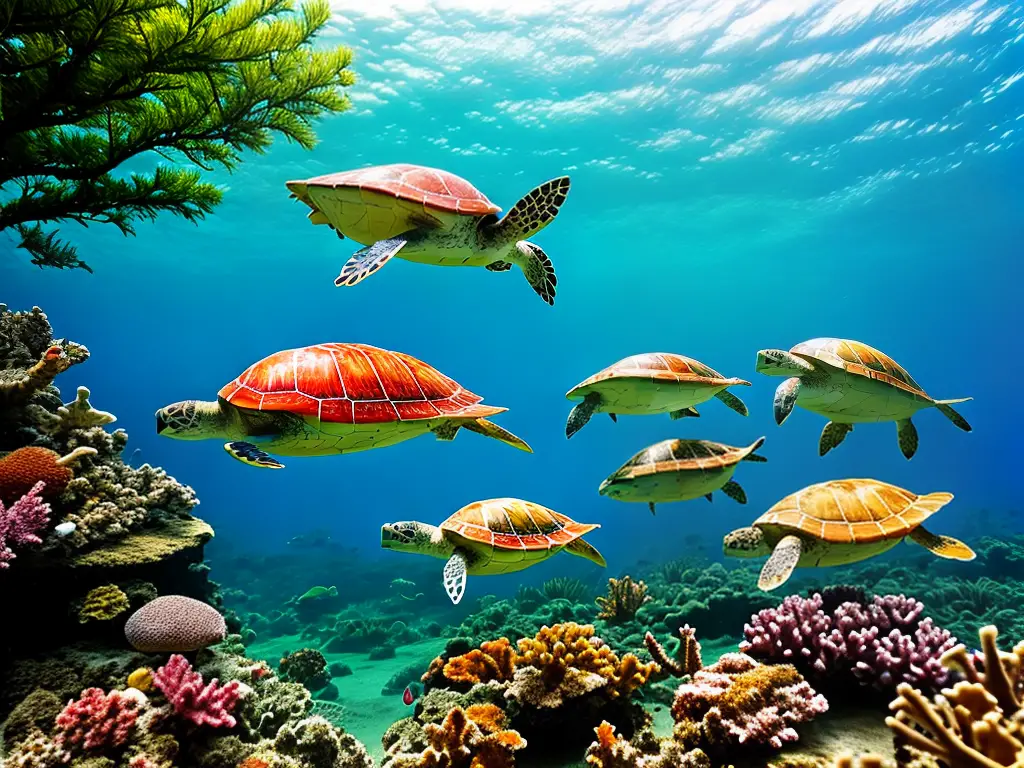
As we embrace the wonders of the most colorful turtles, it is crucial to recognize the threats they face, such as habitat loss, pollution, and climate change. By raising awareness of these extraordinary species and supporting conservation efforts, we can help ensure their survival and continued presence in our world. Let us celebrate and cherish the beauty of these colorful turtles, as they offer us invaluable insights into the mysteries of nature and inspire us to protect our planet’s biodiversity for generations to come.